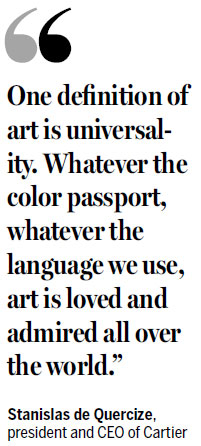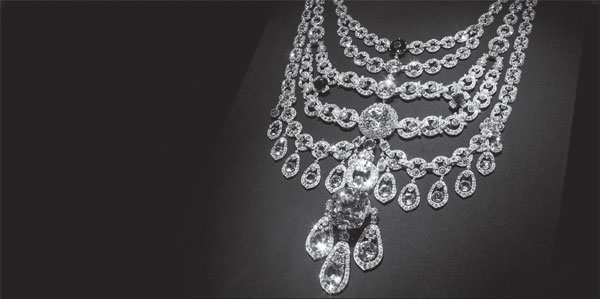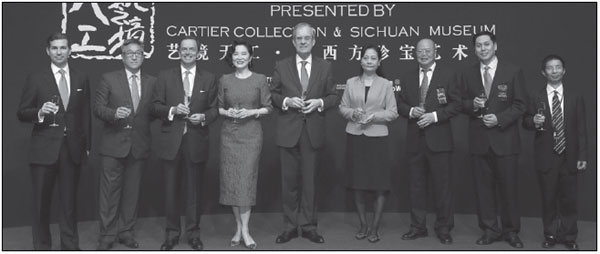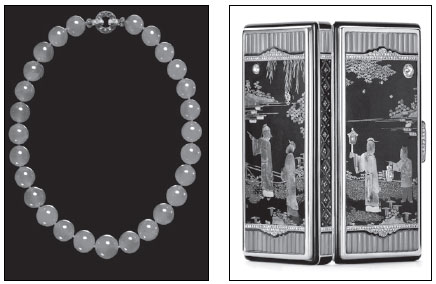Company Special: Best of Cartier artistry displayed in Sichuan Museum
It might be just a coincidence that Cartier has the word "art" as part of its name, but the coincidence is justified in an exhibition currently showing in Chengdu, the capital of Sichuan province.
The Making of Art, presented by the Cartier Collection and Sichuan Museum, showcases Cartier's dedication to the art of jewelry and watchmaking since its founding in 1847. Hundreds of Cartier's precious pieces are displayed alongside 87 pieces from the Sichuan Museum collection. The exhibition opened on April 18 and runs until July 28. "What we want to do is present a dialogue between the French culture, represented by Cartier, and the Chinese culture. It's interesting to see two cultures corresponding with each other, talking to each other about beauty and art," said Stanislas de Quercize, president and CEO of Cartier. He visited Chengdu in April for the opening of the exhibition.
Among the precious pieces, 13 are being shown for the first time. The biggest attraction is a jadeite bead necklace made in the 1930s and owned by the late Barbara Hutton. The necklace was given to the US socialite, heiress and philanthropist by her father when she wed Georgian Prince Alexis Mdivani, and the piece has become a legend in itself.
Cartier bought back the necklace at Sotheby's Hong Kong last year for a record breaking $27.44 million (170 million yuan), making it the most expensive piece of jadeite jewelry in the world.
"It is as beautiful and desirable as it was in 1937. The definition of art is what is timeless. You can adore it and look after it after many generations," de Quercize said.

The exhibition is a chronicle of Cartier's style, which has been inspired by cultures around the world. The founders and designers of the house traveled as far as India, China, Egypt and Russia to gain inspiration. Those influences are reflected in works such as a Chinese vanity case, the Patiala Necklace and an Egyptian vanity case.
"One definition of art is universality. Whatever the color passport, whatever the language we use, art is loved and admired all over the world," de Quercize said.
Cartier began retrieving its most valuable historic pieces from auctions and individual collectors 30 years ago. The Cartier Collection now has more than 1,500 pieces of the house's most spectacular jewelry, watches and valuable items.
"The idea was to be generous and to share beauty with a larger audience. Not everybody can acquire such a collection, but it's important to share it with a wider audience because beauty is to be shared," de Quercize said.
The collection continues to be a pool of inspiration for the brand.
"With this collection, we can chronicle the roots of Cartier. The branch of the tree can go no further than the roots," he said.
It is the 30th time the Cartier Collection has held exhibitions around the world and the fifth time in the Chinese mainland, which has become a "second home" for Cartier, de Quercize said.
Previous exhibition venues include the Metropolitan Museum of Art in New York, the Grand Palais in Paris and the Palace Museum in Beijing.
In addition to protecting its own artistic roots, the brand is also encouraging new creative forces with Fondation Cartier pour l'Art Contemporain, often known simply as the Cartier Fondation, which has been discovering and promoting contemporary artists since 1984.
The nonprofit museum has commissioned more than 3,000 pieces of art from around the world. It has also hosted exhibitions for Chinese artists including Cai Guoqiang, Yue Minjun and Huang Yong Ping.
"We want to share contemporary art with the world and the emotions behind it. We help emerging artists have awareness, recognition and success," de Quercize said.
sunyuanqing@chinadaily.com.cn


|
Guests toast to open the exhibition at Sichuan Museum. Photos Provided To China Daily |
|
Left: A jadeite bead necklace owned by Barbara Hutton in the 1930s. Right: A Chinese vanity case at the exhibition. |
(China Daily 05/08/2015 page14)
















